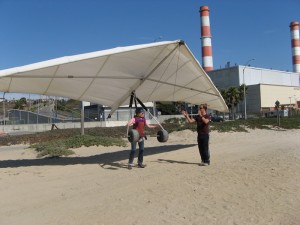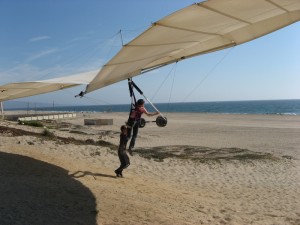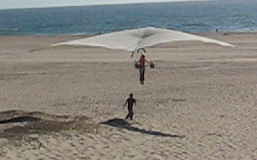How to hang glide
September 9th, 2012 at 1:22 pm (Sports)
Yesterday I got to hang glide for the first time. Windsports Hang Gliding offers introductory lessons at Dockweiler Beach. Under the guidance of an instructor, you get to launch and sail out over the sand dunes on your own!
For my first few flights, the instructor served as a set of training wheels as well as a source of useful shouted instructions. He held on to one side of the glider and kept it stable until I got a feel for its motion. A 30-foot wingspan makes it quite unwieldy to manipulate unless you’re working with the wind and can sense the glider’s position through your body. Here I’m learning how to stabilize the glider, before launching, which at that point genuinely feels like having a giant kite strapped to your back (I’m clipped in behind my back via carabiner).

Next, you run forward and launch off the hill. Running is harder than it sounds, since the glider immediately wants to lift you up, at which point you lose the ability to run. You have to hold it down until the right moment when it lifts you (so smoothly) upward.

Pushing the bar forward shifts your weight back relative to the glider and makes it climb (and slow). Pulling the bar towards you does the opposite (and makes you go faster). Turning is not accomplished by any kind of leaning. Instead, you pull the right bar towards you to turn right, and pull the left bar to turn left. This makes sense, as it simply moves your body weight around and controls the kiteglider with simple physics.
Except it takes a while to figure out how to implement this. You only need to pull briefly, then return to center, and a second or so later, the glider responds with a turn. That kind of delayed response is initially challenging to deal with. Everyone in the class over-steered, holding the bar until the glider actually turned, which is when you want to already be back in a neutral position (unless you’re aiming for a real bank, not just a bit of trim). Apparently for an even stronger turn, you can yaw the glider (make it pivot around its vertical axis) by pushing outward with the non-pulling hand, but I didn’t get to try this.
Here I am up in the air, with the helpful instructor trotting below and giving instructions:

You land by losing altitude (natch) and, just at the end, pushing the bar out to raise the nose, slow the glider, and give you a gentle stop as you land on your feet. One time I forgot to do this, or did it too late, and landed dragging my knees, which was amusing rather than painful (beach sand!).
Overall, this was a surprisingly tame experience. There wasn’t one moment when I thought “yikes!” The glider moves so smoothly that you barely notice you’re off the ground. No crashes, no calamities. Our instructor commented that hang gliding is no longer considered an extreme sport (!). There are, of course, still accidents and casualties. One source says that the chance of dying while hang-gliding is 1 in a thousand pilots, which seems extremely high. But this is calculated over “regularly participating pilots beyond the student level”; apparently there are very few student casualties. A U.K. source, however, reports a rate of 1 in 116,000 flights (and note that the risk of dying from childbirth is an order of magnitude higher, at 1 in 8,200 maternities). Hmm.
Each of our flights were about 30 seconds long (so short!). The same company offers tandem glides off a cliff, where you get 15-minute flights and, presumably, much more time to actually to feel the glider’s response. Tempting!